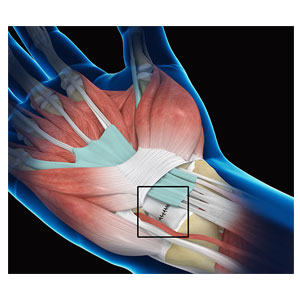What is a Wrist Ligament Tear?
A ligament is a strong, flexible band of fibrous tissue. The wrist has many ligaments that help to keep the wrist bones in proper position providing stability to the joint. A torn ligament causes the wrist bones to move out of their position, which in turn leads to wrist instability as the sprained (torn) ligament can no longer support the wrist bones.
Types of Wrist Ligament Tears
Wrist ligament tears may be classified as:
Grade 1: Wrist ligaments are stretched and have microscopic tears
Grade 2: Wrist ligaments are partially torn
Grade 3: Wrist ligaments are completely torn off from their bone attachments.

Causes of Wrist Ligament Tears and Instability
Wrist ligament tears occur when they get stretched beyond their normal limits. Overstretching of the wrist ligaments may occur due to:
- Falling onto an outstretched hand
- Sudden twist or bend of the wrist
- Extreme pressure on the wrist
What are the Signs or Symptoms of Wrist Ligament Tears?
The major symptoms of a sprained wrist include:
- Swollen and painful wrist
- Limited movement of the wrist and/or hand
- Feeling of popping or tearing sensation in the wrist
- Warmth and tenderness around the injury
- Bruising of the wrist
- Instability of the wrist
How is a Wrist Ligament Tear Diagnosed?
Your doctor will ask you how the injury occurred, discuss your medical history, and perform a thorough physical exam of your wrist. Additional tests such as X-Ray, MRI, or Arthrogram may also be ordered to confirm the ligament tear.
How is a Wrist Ligament Tear Treated?
Minor-to-moderate wrist ligament tears may heal on their own with home treatments like the RICE protocol.
- Rest: Rest the injured wrist
- Ice: Use ice packs immediately after the injury to reduce pain and swelling; 20-30 minutes at a time, several times a day. However, you must never apply the ice directly on the skin as it can damage skin tissue and cause frostbite.
- Compression: Wear a flexible compression bandage (ACE) to reduce swelling.
- Elevation: Raise up the wrist higher than your heart as often as possible to allow fluid to drain away from the site of injury.
Additionally, you may be recommended:
- Nonsteroidal anti-inflammatory drugs to help with pain and swelling
- A cast or wrist splint to keep your wrist immobile during the healing phase
- Stretching and strengthening exercises under a physical or occupational therapist to prevent re-injury
However, if the condition is severe (snapped or fully torn ligament with nearby tissues and bone also injured), surgery may be required.
